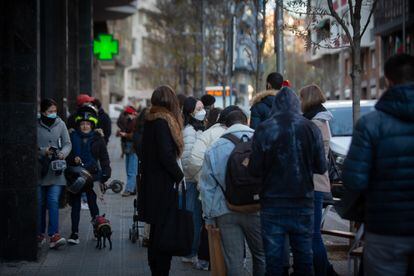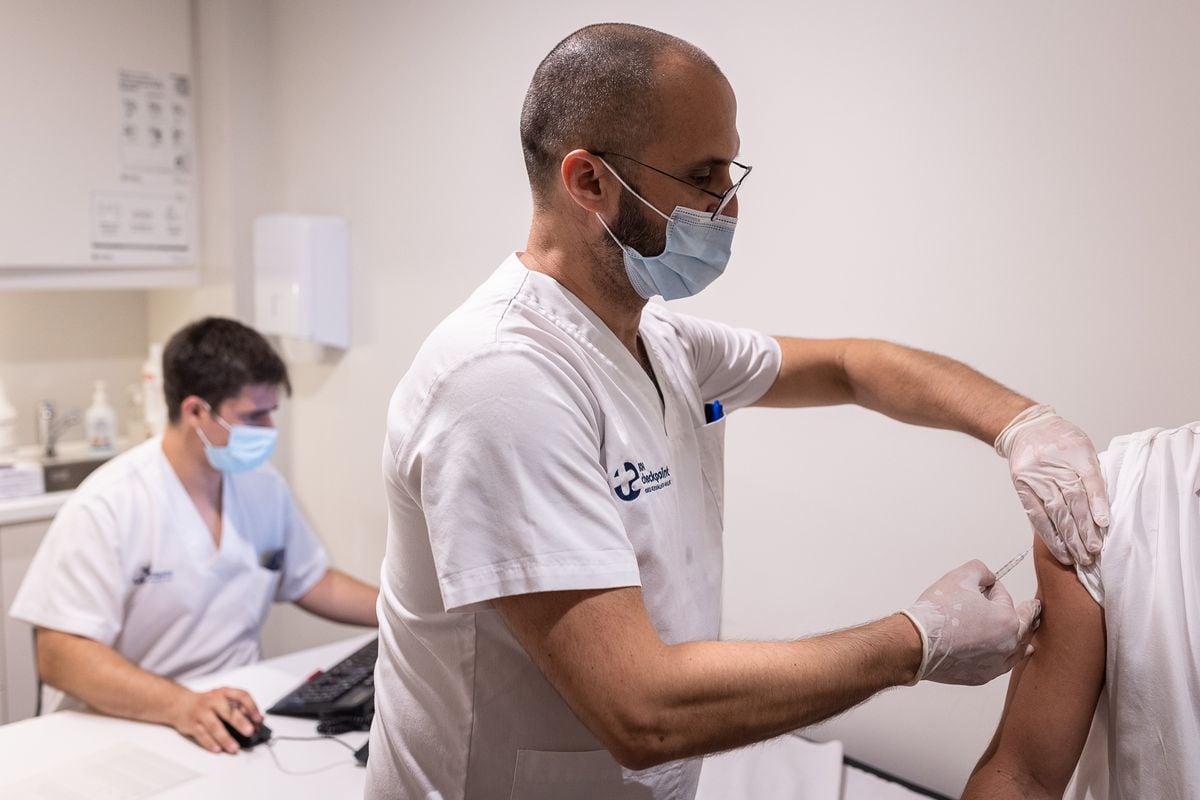Spain has registered this Thursday the highest daily number of covid infections, 72,912, and the accumulated incidence record for 14 days, 911. The sixth wave has exceeded all the figures since there are reliable data, that is, since the second, because the count was not solid in the first moments of the crisis. Knowing the new positives is the basis for being able to control the pandemic: it allows to have information about what is happening, how the virus is evolving and, therefore, to take the appropriate measures and cut the transmission chains so that the infection does not continue to spread. And Spain, in a comparison with the rest of Europe, is at the bottom of the table.
The autonomous regions are increasing the number of diagnostic tests they carry out. In the last week in the communities there have been 1.6 million, about 4.9 a day for every 1,000 inhabitants; the previous week the rate was 2.8, with 950,321 tests. However, this figure, which has grown in recent days, does not reach the European average. Spain ranks 18th out of a total of 28 states (those that make up the EU plus the United Kingdom) in daily analysis per 1,000 people, according to the Our World in Data website, linked to the University of Oxford. And it does not rank well on another key indicator for whether a country is taking the necessary number of tests: the percentage of people who, when taking a test, test positive. Of those same 28 countries, 16 have a lower percentage of positivity. According to the World Health Organization,that percentage must be below 5%. In Spain, this Thursday it stood at 14.7%.
The 4.9 daily tests per 1,000 inhabitants carried out by Spain contrast with the 95 in Cyprus, the 40.5 in Denmark, the 32.3 in Greece or the 19.4 in the United Kingdom (according to the latest data available from the web Our World in Data, which correspond to December 16). Among the 10 countries that do less tests than Spain are seven countries from the East, but also Germany (2.9) and the Netherlands (3.3), which also appear much worse portrayed in the indicator of positivity of the tests, and Finland (3.9).
The low level of Spanish testing has been a constant throughout the pandemic: since March 2020, the highest rate reached was 5.5 tests per 1,000 inhabitants, in June of this year, during the fifth wave. In part, it has been due to the strategy adopted. Epidemiologist Pedro Gullón explains that Spain "has never been one of the countries that tests the most, its policy has been quite aimed at people at certain risk, with confirmed positive symptoms or contacts."
According to Gullón, this strategy has a meaning and an epidemiological criterion. When a resource is "limited" for any reason, the use of that resource is focused on "where the probability before the test is highest, that is, when there are clear reasons to do so", as in the case of vulnerable people, with suspected infection or close contacts. This limitation to which the specialist refers may come from the necessary expendable material, the human resources available or the quality of the infrastructure to execute them. Or, as in the first wave, because none of the above was in optimal condition due to the sudden arrival of the pandemic. But it is no longer March 2020, and at times of very high transmission - such as the current one, and through which it has already been passed up to six times -,This low testing can cause the escape of positives, underdetection.
Open spaces for mass detection
Furthermore, in Spain, “large available spaces” for mass testing have not been common, points out the epidemiologist: “I think it would have facilitated containment to have spaces outside the health system, although the strategy remained the same.
With the arrival of omicron, the system is saturated and those spaces would have helped a lot ”.
Not only because capacity would have been increased, but also because primary care, where the majority of patients are now concentrated, with mild symptoms, could continue with their care for other pathologies, already paralyzed in many health centers due to the pressure of care that is causing the coronavirus.
Madrid, for now, is the only autonomy that has implemented these points in the main hospitals in the community.
Health personnel attend to people queuing for a PCR in front of the University health center in Malasaña, in Madrid on the 20th Andrea Comas
Madrid is also the only community that has changed the case management protocol, recalls Julián Domínguez, member of the Spanish Society of Preventive Medicine, Public Health and Hygiene (Sempsph).
From this Tuesday, a positive in a self-diagnosis test will count for the Madrid health system as a confirmed case.
The community has peaked in detection and the system is unable to absorb the explosive increase in infections in the last week.
The cumulative incidence in 14 days has climbed to 1,284 cases per 100,000 inhabitants.
In the United States, President Joe Biden has also opted for something similar and from January he will deliver 500 million free tests at home to try to stop the advance of the omicron, which is already the dominant one in that country: 73% of the new cases correspond to this sublineage. In Madrid, according to information from the Ministry of Health late Tuesday afternoon, it was already 80%.
This decision - in which in practice oneself is analyzed, confined and traced -, with which it is tried to cut the transmission of the newly infected as soon as possible, although there is no official confirmation, contains some risks.
Gullón points out that the notification systems may not work well, "for example that the citizen, for different reasons, does not notify this positive";
and that there is an underdetection of cases;
and a labor problem, "because when one is positive, it is not given by a telephone, but by a primary school doctor."
A negative is not always a negative
That, among the population that tests positive. But Óscar Zurriaga, vice president of the Spanish Epidemiology Society, recalls that the antigen tests that can be purchased in pharmacies are a test for specific conditions: “Using it in any way and at any time is not recommended, they have been created for people with symptoms in the first days of infection ”. A positive will almost always be a positive, but a negative can be a false negative. The false sense of security is another danger, especially in a population that is mostly vaccinated, with mild symptoms or even without them. And even more so in the current moment, days in which citizens begin to move to reunite with their family and friends at Christmas.
Domínguez, the Preventiva practitioner, adds that “there may or may not be someone who communicates positive or negative depending on a specific interest or that it is simply done incorrectly, the notification of this result is voluntary and by telephone, there should be a system that allow a confirmation, with a QR code or an image, for example ”. In addition, he points out, when a person diagnoses himself and isolates himself, even if he communicates that positive, the system does not study his contacts: “If he wants and can, he does it himself positive, but this is a bit of
epidemic fiction
, we cannot believe that people do it well or do it always ”.
Zurriaga points to the advantage: "Discovering positives that would have gone unnoticed if it had not been done."
Julián Domínguez adds that in other countries the tests have been more “open”.
In the United Kingdom, for example, “free tests are received for the control of children and they are communicated electronically through a QR code”;
and in Denmark there are many places where the population can take a test, for free too.
Although "increasing the number of tests carried out would be optimal", says Zurriaga, "the system is very stressed and you really have to have the capacity, especially PCR", whose process is more laborious.
PCR or antigen test
Even so, all the autonomous regions, except Madrid and the cities of Ceuta and Melilla, continue to carry out more PCR than antigen tests.
And with mixed positivity.
The average is, at 14.7, it is widely exceeded by regions such as Castilla y León (20.4%), Aragon (19.7%) and the Valencian Community (19.3%);
and at the other extreme, Extremadura (9.7%) and Cantabria (10%).
If the comparison is made with the rest of Europe, Spain does not do well either in the classification of percentage of positivity.
Several people queue to take tests and other covid tests, in Barcelona on the 20th David Zorrakino (Europa Press)
At this point and these figures, the room for maneuver is already slim.
"That such a rise has occurred one week before Christmas, which implies a lot of mobility and many meetings, does not help at all," says Gullón.
The growth, he explains, "will continue for a few days", because the incidence in seven days - which provides a forecast for the following week - is high (563 cases per 100,000 inhabitants this Thursday).















